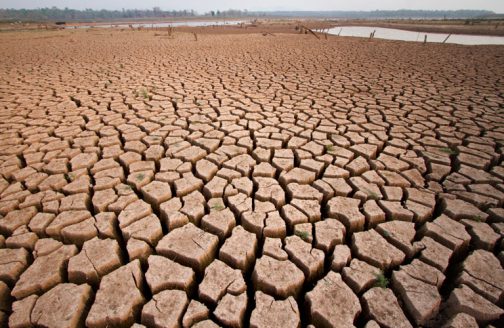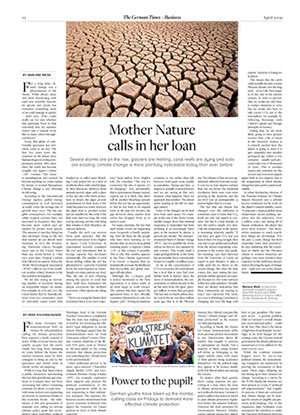Climate change is more painfully noticeable today than ever before

For a long time, climate change was a phenomenon of the future. While always more and more threatening with each new scientific forecast, its gloom and doom has remained something most of us could manage to ignore – until now. Who could really say for sure whether this particular flood or that extremely hot, dry summer wasn’t just a natural event like so many others throughout history?
Today, that phase of comfortable ignorance has definitely come to an end. The last five years were the warmest on the planet since humans began recording temperatures around 1880; since then, the Earth has become roughly one degree Celsius (1.8F) warmer. This trend is unambiguous and extends far beyond anything we could explain by means of normal fluctuations. Climate change is very obviously in full swing.
According to the International Energy Agency, global energy consumption in 2018 increased at nearly twice the average rate of growth since 2010. This has tangible consequences. For example, while tropical cyclones have not increased in frequency, they have become more violent and are marked by greater wind speeds. The amount of rain they bring has also increased, owing to the fact that warmer air can absorb more moisture. In 2017, the devastating Hurricane Harvey brought more rain to the United States than any storm before it. Only two years later, Tropical Cyclone Idai followed in eastern Africa; the World Meteorological Association (WMO) called it one of the deadliest weather-related disasters to hit the southern hemisphere.
We are also seeing an increasing number of incidents having an irreparable impact on nature. For example, in 2016 and 2017, the Great Barrier Reef in Australia suffered from two consecutive years of extremely warm water that resulted in so-called mass bleaching. Coral polyps live in a kind of symbiosis there with colorful algae. In their limestone skeleton, these animals provide algae with a place to live and also offer them protection; in return, the algae provide nourishment for their hosts. If the water becomes too warm, however, the algae start to produce toxins and are repelled by the coral. If the heat wave lasts too long, the coral end up starving, and the only thing that remains is their bleached calcareous skeleton.
Usually, the reefs can recover from such episodes. But the research team under Terry Hughes at James Cook University in Queensland recently examined the reef and determined that its recoup capacity has decreased dramatically. The number of coral larvae settling within the reef has plummeted to 11 percent of normal levels, the team reported in Nature. Simply too many parents are dead. Plus, the rate of new offspring among the species of coral that have, until now, dominated the unique ecosystem, has declined even more. Other species are taking over.
“We’re not saying the Barrier Reef is doomed, but it is on a new trajectory,” had author Terry Hughes told The Guardian. “The way it’s connected, the mix of species, it’s all changing.” And, presumably, this is a permanent change: indeed, experts say it is likely that there will be another bleaching episode before the reef has an opportunity to find its way back to its original form. In the past few decades, the gap between these marine heat waves has dropped from 25 to under 6 years.
For many scientists, the fact that such drastic events are happening more frequently is hardly surprising. After all, these are the people who have been warning us for decades that we need to keep global warming under 1.5 degrees Celsius (2.7F) in this century, if possible. This is why that number appears in the Paris Climate Agreement: if we exceed 1.5 degrees, then we dramatically increase the likelihood that irreversible and global damages will take place.
Although the 1.5-degree goal is indeed mentioned in the Paris Agreement, it is noted solely as an ideal target to work toward. The nations that have signed the agreement have, in fact, officially committed themselves to only two degrees (3.6F). As long as emissions continue to rise rather than fall, however, both goals seem equally as unrealistic. Having said that, 1.5 degrees is actually a natural border, and we are seeing at this very moment what happens when we approach that number: The planet starts sending us the bill for damages caused.
Some of the changes can be best seen from outer space. For example, in the case of the Arctic Ocean, satellite images show that minimal expansion in September has been declining at an increasingly faster pace, at the moment by almost 13 percent per decade. The Intergovernmental Panel of Climate Change (IPCC) says it is possible the Arctic will see its first ice-free summer by mid-century. This would mark a major geological break, as the Arctic has presumably been continuously frozen for roughly 2.6 million years.
As far as the concentration of CO2 is concerned, the earth already has a level that it once had even further back in history. Since the dawn of industrialization, the concentration of carbon dioxide in the air has risen from 280 ppm (parts-per-million) to more than 400 ppm. The last time so much carbon dioxide was in the air was three million years ago, that is, in the Pliocene era. The climate of that era was significantly different from ours today: It was two to four degrees warmer than the era before the industrial revolution; there were even trees growing in the Antarctic; and the sea level was an unimaginable 15 meters higher than it is today.
The fact that our climate has changed over the millennia is sometimes used to insist that CO2 levels are only one aspect to consider. But this is a fatal mistake: in fact, the earth is simply very slow. Only the temperature at the surface is increasing relatively rapidly. “If you have 400 ppm CO2 and you keep it there for long enough, then you start to get additional feedback from the slower-responding components of the system, that amplifies warming,” says Alan Haywood from the University of Leeds, an expert in past climates. It takes a while until the ice sheets or the oceans change. But when the time comes, they start raising the temperature further upwards, for example, because ice-free water surfaces reflect less solar radiation. “Actually, there are already indications that these components are starting to react,” says Haywood: The Arctic ice cover is shrinking, Greenland is changing, and even the huge cold eastern Antarctic is losing ice in places.
This means that the earth could actually become a warm Pliocene climate over the long term – even if the Paris target is, in fact, met in the current century. In order to prevent that, we would not only have to reduce emissions to zero, but we would also have to take excess CO2 out of the atmosphere, for example, by following Bioenergy with Carbon Capture and Storage principles in forestry.
Failing that, we are most likely going to have greater worries than a bit of forest in the Antarctic. Indeed, it is entirely unclear how the planet is going to react if it gets catapulted into another geological age within a few centuries – usually such processes take tens of thousands of years. This is another reason why scientists see the second and even more urgent upper limit at two degrees: that is the temperature at which climate change becomes pretty much incalculable.
As Johan Rockstroem, director of the Potsdam Institute for Climate Impact Research and a scholar known worldwide for his work on the planet’s natural stability, notes: “Going past 2 degrees global mean temperature means pushing ourselves into the unknown: Over 3 million years, and during all of human civilization, the planet has never been warmer.” And Rockstroem continues to watch exactly how things are developing: “For the past 15 years, change has been somewhat faster than predicted,” he says, admitting that the Greenland ice shield and the Thwaites Glacier in western Antarctica are perhaps even more sensitive than expected. In fact, both have already started showing the signs of change now – right now, not in the distant future.
Marlene Weiß
received her doctorate in particle physics from ETH Zurich and CERN (Geneva) and is a science editor for the Süddeutsche Zeitung.




